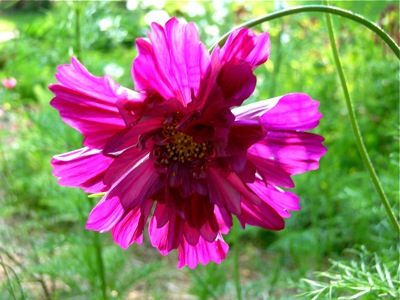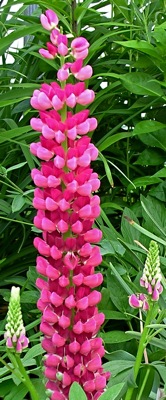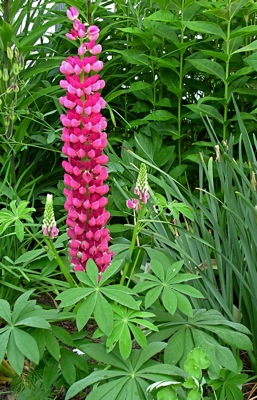Internet Garden Catalogs – the missing Link
In the old days ( like before about 2005), seed and nursery catalogs were glossy shopping magazines. They came unbidden in the mail just when you were sick to death of winter, bearing page after page of enticing close ups: brilliantly colored trumpets and daisies, clusters of nodding bells and panicles of jewel-drops, all guaranteed to make you forget that your garden was not the size of Versailles.

Cosmos bipinnatus 'Double Click'
Understandable. Closeup photos are the easiest to take, for one thing. Plus we know from the garden center in spring that nothing sells as well as eye candy. Add the fact that printing and postage are big expenses, and it’s no wonder the mail box wish books cut right to the chase.
But on the net, production costs are the same for one catalog or ten million; distribution is dirt cheap and space limitations have no meaning (let’s hear it for links!).
So why do we see mostly this:

Lupine 'Morello Cherry,'
and nothing else?
In other words, why are most online catalogs simply uploads of the print version, albeit sometimes faster to search and not infrequently expanded with growing tips, links, and photographs of the family dog?
It’s still wall to wall flower close ups, unsupported by additional views. Oftentimes you can blow them up supersize. But can you see this?

lupine 'Morello Cherry,' in front of phlox, beside garlic chives
Almost never. Even though flowers grow on plants, plants that are there before and after bloom, those plants are missing in action.
It’s bad enough when you’re dealing with something familiar; different cultivars often have strikingly different proportions. But if you’ve never seen the plant you’re really up the creek sans paddle when it’s time to figure out where said plant fits in the larger scheme of things.
What do the leaves look like and how are they arranged? Is the growth dense or airy? Rounded? Pyramidal? Columnar?
We burn to know. There are some suggestions of how this might look at Annie’s Annuals, where some (alas far from all) of the offerings have a dual portrait – check out the Kniphofia caulescens for an example. I’ve never ordered anything from Annie’s so cannot speak to quality or service, but in the online catalog department they appear to get it. Sort of. And there must be others that do more than reproduce the wholesalers’ mugshots – do you know any?
Just for the record, since the only cosmos here is (mea culpa) the close up, in our gardens Double Click is a paltrier plant than old fashioned Sensation or my favorite Psyche. In Maine, it’s short, in New York tall, but in both gardens it’s spindly – even when pinched to force branching.
Cosmos photo by Kristi Niedermann















This is a discussion Craig and I have often. We’ll be sitting around looking at the glossies and one of us will look at the other and say “But what does the plant look like?”. Craig, with his horticultural backround almost always knows and he’s trained me to be wary of the eye candy. As we mature as gardeners, we are both now more interested in form, function and habitat than in just flowers themselves, although a pretty one can always turn a gals head. But a pretty flower without nectar or pollen is not welcomed here for it provides no sustenance for our busy insects. All that said, that is one stunning lupine.
RW – How’re we going to get Craig to join us here on the blog? It sounds as though he’d have SO much to contribute.
Far as I’ve seem, Morello Cherry does its share insectwise, although it’s not a major feeding trough, and being a legume it improves the soil so there’s that in its favor too.
Second picture shows (I hope) that the plant is small compared to most lupines, while having flower spikes that are if anything bigger. Not a happy combination to me, but that’s a matter of taste. It can bloom the first year from seed if you start it early enough, so finding out if it suits you – or your place suits it – doesn’t take much time or money.
LL- I wish that he would. He used to blog on Cold Climate Gardening, back when he was in-between careers. It has been about two years, but if you follow this link to the CCG archives, you can read some of his posts. He is one smart cookie. Now that he like me, works at a computer eight hours a day, there is little energy left for fun things like blogging- I sneak mine in while I am at work!
http://www.coldclimategardening.com/author/craig-levy/
Forgive my cheerleading here, but Craig also used to have his own blog, again in the time of in-between careers. This post I especially liked:
http://rustlingleavesny.blogspot.com/2007/03/seed-buying-method-or-madness.html
And I thouht you might like it because does a very good job explaining his approach to seed buying.
Cheers!
It’s all potluck, isn’t it?
I grow lots of plants from seed and buy an equal number as seedlings. The sure-thing plants often die the same season they hit the dirt. The challenging seeds often come up and surprise.
This year the seeds that all came up won’t.
The descriptions and the photos are not much of a guide for how they will perform or look in my yard.
I can’t imagine how hard it must be to do plants for a living. It must be sort of like having one of those dating services – most of the time things don’t quite work out as expected.